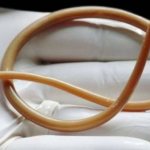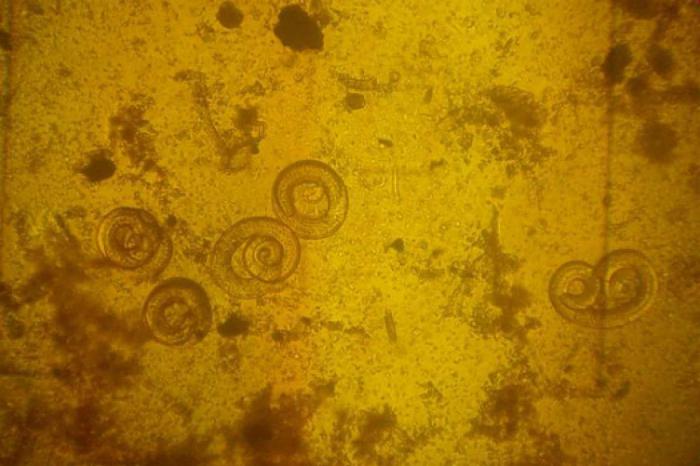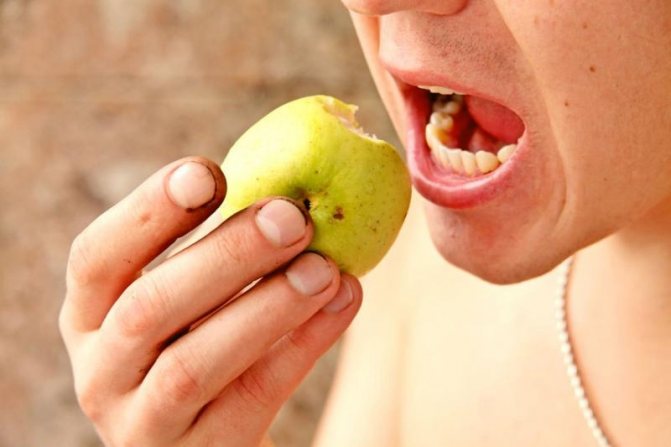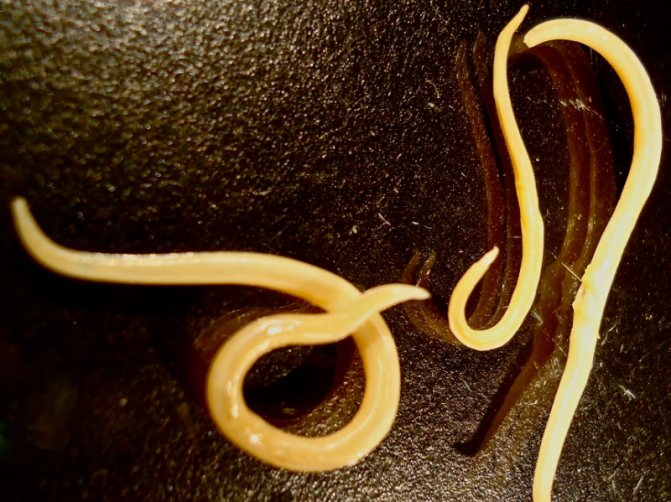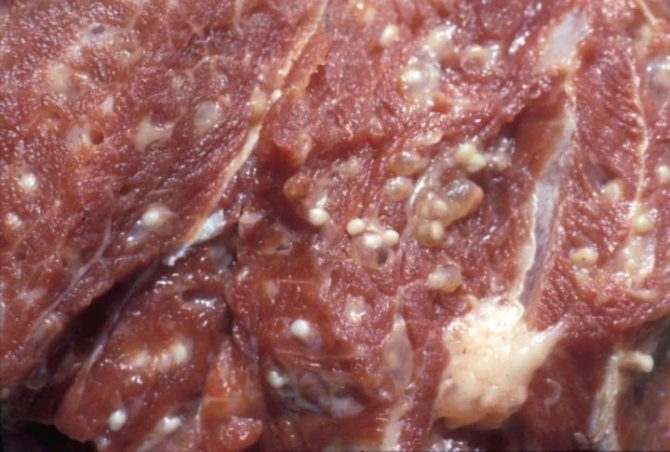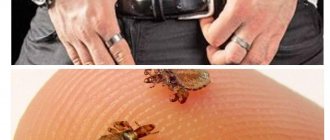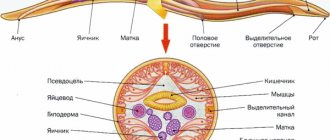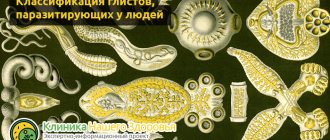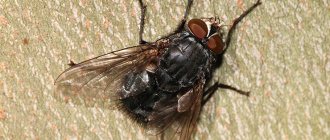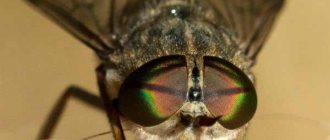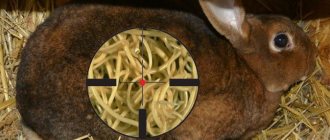Roundworms (Ascaris) are large dioecious helminths from the genus of parasitic nematodes - roundworms. Ascaris lumbrico> The disease is rare in arid regions and dry steppes, absent in desert and permafrost zones. Ascariasis foci are formed in places where the soil is contaminated with helminth eggs. It is believed that in the world about 1.4 billion people suffer from ascariasis, of which 100 thousand die every year.
Among all helminthiasis, ascariasis is 8%. Among those infested with helminths, 72% of cases occur in children. A large number of children and adults with this helminthiasis are registered in rural areas, where there is a low sanitary and hygienic level and a high degree of soil contamination with eggs of parasites.
With the disease, the gastrointestinal tract is affected, toxicosis and allergy syndromes develop, and immunity decreases. With massive invasion, intestinal obstruction is noted, associated with its obstruction with a ball of ascaris. The rupture of capillaries by migrating larvae leads to inflammation of many organs. Increased motor activity of adult ascaris leads to the development of peritonitis, ascariasis of the liver and many other internal organs. The disease negatively affects the course of pregnancy. The immunosuppressive effect of parasites causes a decrease in the child's body response to the introduction of a vaccine against diphtheria, measles, poliovirus and tetanus
Fig. 1. In the photo of the roundworm.
Concept and Description
Ascaris - photo:
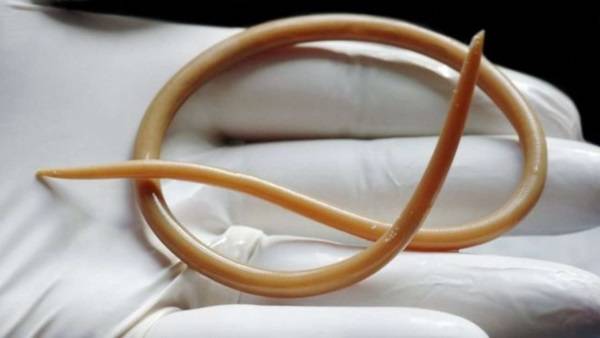
Ascariasis - entry into the human body of a parasite (roundworm), as a rule, at an early stage occurs without any clinical manifestations. The first signs of the disease appear already at a later stage of the development of the disease.
Causative agent of the disease - Ascaris, a parasite belonging to the group of roundworms. Ascaris is quite impressive in size. So, the length of the female can reach half a meter in length.
The size of the males is somewhat more modest (15-25 cm). The life of the parasite is about a year. In the human body, the roundworm reproduces quite actively, one female can lay more than 250,000 eggs per day, of which new larvae appear after 2 weeks.
For the formation of the larva, a special nutrient medium is required, which is not in the human body. Consequently, the larva hatches outside the patient's body, however, there is the possibility of re-infection with such a larva.
Stages of the disease
The course of ascariasis is carried out in 2 stages:
- Early (migratory) stage. The patient has an increase in sensitivity to the waste products of the parasite, as well as to the decay products of its dead larvae. There is also trauma to the tissues of internal organs caused by the movement of the parasite. Blood vessels are damaged, resulting in small internal hemorrhages. There is an inflammation of the mucous membranes of the affected internal organs, the gradual death of their cells.
- Intestinal (chronic) stage... It is characterized by intoxication of the body caused by an increase in the content of waste products of the parasite. In addition, there is a dysfunction of the gastrointestinal tract, multiple damage to the intestinal mucosa.In especially severe cases, there is a violation of the integrity of the intestine, the formation of ulcers and wounds on its walls.
If the roundworm is large, its presence in the intestine can provoke intestinal obstruction, spasms and involuntary contractions of the intestine.The patient has a decrease in immunity, exacerbation of various kinds of diseases.
You can defeat parasites!
Antiparasitic complex® - Reliable and safe disposal of parasites in 21 days!
- The composition includes only natural ingredients;
- Does not cause side effects;
- Absolutely safe;
- Protects liver, heart, lungs, stomach, skin from parasites;
- It removes the waste products of parasites from the body.
- Effectively destroys most types of helminths in 21 days.
There is a preferential program now for free packaging. Read expert opinion.


The best stories from our readers
Subject: Parasites are to blame for all the troubles!
From whom: ()
To whom: Administration
Not so long ago, my health condition deteriorated. I began to feel constant fatigue, headaches, laziness and some kind of endless apathy appeared. There were also problems with the gastrointestinal tract: bloating, diarrhea, pain and bad breath.
I thought it was due to hard work and hoped it would go away on its own. But every day I got worse. The doctors, too, could not really say anything. It seems like everything is normal, but I somehow feel that my body is not healthy.
I decided to go to a private clinic. Here I was advised, along with general tests, to be tested for parasites. So, in one of the analyzes, parasites were found in me. According to doctors, these were worms that 90% of people have and almost everyone is infected, to a greater or lesser extent.
I was prescribed a course of antiparasitic drugs. But this did not give me results. A week later, a friend sent me a link to an article where some parasitologist shared real advice on combating parasites. This article literally saved my life. I followed all the tips that were there and after a couple of days I felt much better!
Reasons for the appearance
Infection with ascariasis is favored by the following circumstances:
- non-observance of the rules of personal hygiene... For example, a child, after contact with the ground or sand, takes food without first washing his hands with soap;
- enters the child's body standing waterinfected with parasites;
- child eats dirty fruits and vegetableson the surface of which the larvae of the parasite are located;
- most often, ascaris infection occurs precisely through foodthat have not been properly prepared.
You can find out about the causes of the appearance and methods of treating atopic dermatitis from our article.
Ways of transferring the eggs of worms to humans
[flat_ab id = ”10"]
When asked what is the route of transmission of ascariasis to humans, the answer is as follows. Ascariasis can be transmitted to humans in one of three main ways:
- Through the water when swimming in open water. Infection occurs when water is swallowed, if land with parasites enters the water.
- Ingestion with food. Unwashed vegetables, fruits.
- Contact and household option. The eggs of parasites are brought into the house on the soles of shoes, on the hands after gardening, through bills, children's toys and even insects.
Clinical manifestations
Among symptoms characteristic of this disease, can be attributed:
- Deterioration of the general well-being of the child, caused by the general intoxication of the body.
- Allergic reactions even to those foods, the use of which has not previously caused such problems.
- Inflammation of the lymph nodes.
- Hyperthermia, sometimes significant (over 38 degrees).
- Dizziness, headache.
- Frequent cough, accompanied by sputum production. In this case, sputum may contain bloody elements.The consistency of sputum is viscous, purulent.
- With the intestinal form of the disease, the child develops symptoms such as diarrhea, decreased appetite, seemingly unreasonable abdominal pain.
In the event that roundworms affect the lungs, characteristic wheezing can be heard when the child breathes.
These signs may have varying degrees of severity.
It all depends not only on the stage of the disease, the location of the parasites, but also on their number.
That is, the more ascaris is in the patient's body, the brighter the symptoms diseases.
Consequences and complications
This disease is considered very dangerous for the child's body.
This is due to the many adverse consequences that an illness can lead to:
- Ascaris cause inflammation of the intestinal mucosa, which causes a violation of the functionality of this organ.
- An infected child does not receive nutrients from the food entering the body, as the absorption process is disrupted. It promotes development vitamin deficiency, decreased immunity.
- The child becomes more susceptible to harmful effects viruses and infections... Diseases are more severe.
- If the parasite enters the respiratory system, it may develop bronchitis, pneumonia.
- The presence of ascaris in the intestinal region can provoke diseases such as appendicitis, intestinal obstruction.
- Parasites in the area of the gallbladder and its ducts cause toxic hepatitis, jaundice.
- Visual impairment, conjunctivitis, inflammation of the mucous membrane of the eyes - the consequences of getting roundworm in the eyes.
- If the parasite is in the area of the ear canal, it can lead to hearing loss.
- The most dangerous consequences of a severe form of ascariasis is considered damage to the central nervous system and brain.
Diagnostic methods
Methods for detecting ascariasis are different, depending on the stage of the disease. At the initial stage, the patient needs to take a blood test (test for eosinophilia), an analysis of sputum for the content of parasite larvae in it, as well as a study on the body's response to ascariasis antigen.
The main diagnostic method in the chronic stage of the disease is the examination of the patient's feces. The intestinal stage involves the content of ascaris eggs in the feces of the child, or the parasites themselves.
In some cases, for example, if only males of the parasite were found in the patient's feces, prescribe X-ray examination.
Diagnostic methods
To recognize the early (migratory) stage of parasitic invasion, it will be necessary to take into account the symptoms of lung damage, blood eosinophilia. Ascaris larvae are rarely detected in sputum samples.
Nowadays, serological diagnostics are practiced, but due to the relatively expensive cost of the study, it is not always carried out. In the intestinal stage, there are indications for an analysis of feces for the presence of eggs or adult ascaris.
When diagnosing helminthiasis, it is necessary to pay attention to the time of year, for example, most infected people are detected in the period from December to February. If only old males or immature females parasitize in the human intestine, there may be no eggs in it.
It may often be necessary to carry out differential diagnosis of ascariasis of the migratory stage with toxocariasis, early stages of other types of parasitic diseases, which are characterized by:
- pneumonia;
- acute bronchitis;
- allergic manifestations.
When the pathology is in the intestinal stage, it is almost impossible to differentiate ascariasis by symptoms.
If complications arise, based on their characteristics, it is required to differentiate from intestinal obstruction, pancreatitis, liver abscess of a different etiology.In such cases, one cannot do without the obligatory instrumental examination, consultation with a surgeon. Depending on what the answer is, treatment will be prescribed.
Information about ascariasis is provided in the video in this article.
Drug treatment
How to remove roundworm from a child? To destroy parasites in the patient's body, he is prescribed taking antihelminthic drugs.
For example:
- Decaris... Prescribed for severe damage to the body. Contraindications: pregnancy and lactation, age up to 14 years.
- Mebendazole... Take 100 mg. twice a day for 3-4 days. Contraindications: age up to 2 years, Crohn's disease, liver disease.
- For the treatment of young children (from 6 months) appoint Pirantel.
Only a doctor can choose one or another drug after a complete examination of the patient. The fact is that these medications are quite toxic, this can cause a deterioration in well-being.
In most cases, preference is given to oral medications... However, with extensive invasion, the funds can be introduced into the body through a special probe.
Not so long ago, for the treatment of ascariasis was used laxativeshowever, their effectiveness has not been proven.
In addition, such therapy can even be dangerous, for example, with intestinal obstruction caused by ascariasis.
When they get dangerous
An amazing feature of ascariasis is that infection from person to person at the household level is impossible. This is due to the fact that the parasite must mature in the soil.
It gets there along with human feces. This happens especially often in rural areas, where sewage is used as fertilizer for plants.
For the comfortable development of roundworm eggs, moderate humidity and a temperature of 26 degrees Celsius are needed. In this case, the larva develops already on the 10-12th day.
If the conditions are unfavorable, then it takes 1-2 months to ripen.
In the ground, roundworms can exist for 6-12 months. According to some reports, 7-10 years old (Maidannik V.G. "Helminthiasis in children").
When the mature eggs of the human roundworm enter the body, they pass through the esophagus, stomach and enter the small intestine. There the parasite is freed from the membranes and the migration phase of the roundworm begins.
Prevention measures
In order to prevent the possibility of helminthic invasion, it is necessary follow a few simple rules:
- wash your hands after going outside, going to the toilet, and just before eating;
- monitor the purity and quality of food and water consumed;
- to carry out sanitary protection of the soil and water supply system;
- fight insects that can carry a large number of various diseases, including carriers of ascaris eggs;
- periodically get tested for the content of parasite eggs. This will identify ascariasis at an early stage of its development.
Ascariasis - a dangerous disease that affects all internal organs and systems of a person... Unfortunately, at an early stage of the course of the disease, it is not always possible to identify it, since the disease can develop almost asymptomatically.
Nevertheless, upon noticing the first symptoms, it is necessary to immediately begin treatment.
It is impossible to prescribe antihelminthic drugs on your own.
Find the right product, calculate its dosage and course of treatment only a doctor can.
About the reasons for the appearance and methods of treatment of ascariasis in this video:
Appearance
The causative agent of ascariasis is Ascaris lumbricoides
... In Russian, this helminth is known as
Ascaris human
... She is a representative of the nematodes, which are better known as the type
roundworms
.
| Specific traits | |
| Length | 15-40 cm |
| Color | Live: white with a pink tint Dead: white or yellow |
| Body surface | Smooth, smooth |
| The ends | Sharp, twisted on one side |
Unlike the earthworm, roundworms have a smooth surface without dividing into segments. If the roundworm came out on its own, it is most often dead, therefore the body color is yellow or white. A pinkish tint is possible.
What to do next
Let's say you saw what an ascaris looks like in a child's feces and recognized a parasite in it.
Don't panic.
Collect the feces together with the worm in a jar and contact an infectious disease specialist as soon as possible. He will send the collected material to the laboratory, where the parasite is identified and the presence of eggs is checked under a microscope.
Even with a negative result, treatment of ascariasis with Vermox, Stop Parasite or other anthelmintic agent will be prescribed.
Ascaris in feces most often appears in people living in places with a warm and humid climate. The human roundworm is a type of roundworm. During the period of development, they go through several stages. A person can become infected with parasitic helminths as a result of the ingestion of mature eggs into the body with food.
A distinctive feature of male and female roundworms is their size, as well as the different shape of the tail.
The male has a body length of 15-25 cm, while the females reach a length of up to 40 cm. The body width of the female is also greater than that of the male.
The end of the tail of the male roundworm is curved and looks like a hook. On the lower part of the tail there are organs of touch. In females, the tail ends in a cone. When females reach puberty, they have a certain constriction around the body in the region of the first part of the body.
Ascaris has a very high reproduction rate... The female can simultaneously contain several million eggs, which have different ripening times. In one year, a healthy female lays up to 65 million eggs. Among the laid eggs there can be not only fertilized, but also unfertilized ones.
The former resemble the shape of an oval, sometimes they are in the form of a ball. Their sizes can be from 50 to 70 microns, with a width from 40 to 50 microns.
While the egg is inside the female, it has a protective shell in several layers. After entering the intestines, the shell of the egg loses its transparency and becomes brown or yellow. This shell is designed to protect the egg from any damage. In turn, the inner shell does not lose its transparency and protects the embryo from chemical attack.
Living parasites are reddish in color and spiral in shape. After their death, they acquire a light yellow tint. Ascaris eggs along with feces enter the external environment. Moreover, they are able to ripen only at the right temperature and percentage of humidity, as well as aeration.
So, at temperatures from +13 to + 30 ° inside the egg, the larva ripens for 10-40 days. If the egg is in an environment with a temperature of +24 to 30 °, then the larva can mature in 18 days. A temperature of + 12 ° C and below is not favorable for the development of the embryo, however, its development, as well as the viability of eggs, remains until the onset of better conditions. The eggs of these parasites are able to live in the soil for 10 years.
Human infection with ascariasis occurs as a result of eating the eggs of these helminths. They get inside the human body along with fruits, vegetables and berries, on which there are particles of earth or grass. Also, dirty water and hands can be the cause of this disease.
It is worth paying attention to the fact that today in summer cottages, human feces are used for fertilization, and this leads to the proliferation of eggs and larvae of roundworms. In places with a temperate climate, ascariasis can be infected from April to October, and in areas with warm and humid conditions, infection occurs throughout the year.
There are unfertilized eggs, the shape of which can be any: elongated, rounded, triangular, etc.Their length can vary from 50 to 100 microns. The white shell of the egg has a rough surface, on which there are long and short teeth, alternating with each other.
The inside of the egg is filled with yolk cells. Sometimes eggs are found without an outer protein shell. Such an egg is very difficult to recognize as it resembles a plant cell. Therefore, during diagnosis, it is difficult to detect roundworms in the feces.
The development of helminth occurs in the host in the small intestine.
When infected with parasites of two sexes at once, females lay eggs that are capable of carrying out the full biological stage of development. If only 1-2 females parasitize, then in this case they hatch unfertilized eggs. These eggs do not develop further. However, on clinical examination, the detection of such eggs is important, as they confirm the presence of an infestation.
Ascariasis in humans develops as a result of non-observance of simple hygiene rules. The disease has two phases of development: migratory and intestinal. The larvae of these worms, being in the intestines, are freed from the egg shell. After that, they penetrate into the mucous membrane and capillaries. Then they move to the liver, and can also appear in organs such as the heart and lungs. Through damaged capillaries, parasites migrate further, ending up in the oral cavity.
A person, swallowing food and saliva, sends parasites into the stomach, from where they enter the intestines. Here they develop to the stage of mature individuals. The entire migration process takes up to 14 days. Adults in the intestines release eggs only if the larva has passed all stages of migration.
After a person has become infected with ascaris, after 2.5 months, the dead parasites, together with feces, come out. However, it should be borne in mind that with a disease in adults, some complications may arise, so they must undergo a mandatory course of treatment. If ascariasis continues to bother you for about 14 months, you must repeat the treatment procedure.
During the migration phase of the development of ascariasis, pathology may occur caused by the metabolic products of parasites or their decay, which are strong allergens. As a result, a person develops concomitant diseases such as hepatitis, skin irritation, as well as lung and blood diseases. During the passage of the intestinal phase of the disease, allergens are also present, but they are much less pronounced.
TAlso, during migration, the larvae can injure the tissues of some organs, resulting in various diseases. Adult parasites can cause serious injury due to the fact that their bodies are sufficiently mobile and strong. As a result, disturbances in the work of the gastrointestinal tract and other pathologies may occur.
Ascaris, penetrating the liver or respiratory system, can cause serious surgical consequences. With surgical interventions, ascariasis can also cause some complications.
During the migration of larvae, the disease proceeds without obvious signs. Most often, she shows signs of allergies, as well as pneumonia. At this time, chest pains, weakness, coughing, a small rash on the skin and a slight increase in temperature appear. In addition, the liver is enlarged.
With chronic ascariasis, a person feels an uncomfortable state in the area of the digestive tract. Food in the intestines begins to move faster, while the absorption of nutrients is weaker. The body does not perceive some foods at all, such as milk. At this time, pressure may drop, a malfunction of the nervous system occurs, etc.
Against the background of general symptoms with helminthic diseases, there are some signs that are characteristic only of ascariasis.
It is on them that doctors are guided when making a diagnosis:
- Pain in the abdomen, which appears often and suddenly, then go away.
- The skin is pale with a yellowish tinge.
- The body weight of a person is usually below the required norm.
- Loss of appetite, even aversion to food.
- The appearance of frequent salivation, nausea and vomiting.
- Stool disorder (or loose or constipation).
- In a dream, teeth grinding is heard.
- Roundworms are observed in feces.
The main treatment for ascariasis is the use of anthelmintic drugs. Means such as Dekaris and Pirantel are very effective. In parallel with medications, a special diet and multivitamins are additionally prescribed. For severely ill patients, detoxification therapy is prescribed. If any complications are found, the patient is prescribed an operation.
Today, ascariasis is successfully treated with oxygen. It is introduced into the stomach through a tube. The procedure is performed on an empty stomach 2-3 times. After 20 days of treatment, a fecal test is performed to determine the result of the therapy.
With ascariasis, the patient adheres to a diet corresponding to the treatment table No. 5. It is necessary to significantly reduce the consumption of fatty foods, alcoholic beverages. At the same time, increase your intake of protein-rich foods. Pay special attention to hygiene: thoroughly wash vegetables and berries in clean water, try to drink only boiled water.
The main thing is to prevent the presence of human and animal feces in yards, playgrounds, as well as in personal plots. You should be aware that direct sunlight is detrimental to ascaris eggs, so you should often loosen the sand in the sandboxes.
The use of certain plants that secrete special substances also help in the fight against helminths. It is advisable to plant such plants as calendula, lupine, peas, etc. in the yard of the house or in the country. The best prevention against the development of ascariasis is personal hygiene. It is necessary to teach the child not only to wash their hands after the street, but also to rinse fruits and berries well before use.
About Ascaris eggs
After the larvae hatch, they can spread throughout the body, thereby affecting many organs and provoking allergies. The reproductive system of this type of worm is very well developed and an adult female can lay up to 240 thousand eggs per day, which is clearly visible in the photo. Male and female have certain differences in their species, which are manifested primarily in their size. The body length of the female is much longer than that of the male.
Unfertilized ascaris eggs are located in a special spermatic receptacle of the female, where the fertilization process actually takes place. Unfertilized ascaris eggs do not bring absolutely any harm to humans, since larvae will not appear from them, and infection will not occur.
Roundworm eggs mixed with feces go outside, then penetrate into the soil, where their subsequent maturation takes place. Their accidental penetration into the body makes it possible for the subsequent development of worms. It is for this reason that most of the embryos of worms die, although they are quite resistant to negative influences.
Features of helminths
Roundworms are medium-sized roundworms that settle in the human gastrointestinal tract. They are larger than pinworms, but much smaller than the classic representatives of the cestode class - tapeworms and tapeworms. Females of these worms reach 40 cm, and males - 25. Such differences are due to the fact that eggs ripen in the body of a female, which then go outside and become a source of invasion for uninfected people.
Roundworms settle in the human small intestine and continue to live there for 1-2 years. Worms have dense integuments that reliably protect them from adverse factors, the effects of digestive enzymes secreted by the pancreas and liver. These worms do not have special devices for fixation in the host's body, therefore, adult ascaris are forced to constantly move up the intestinal tract.For this reason, they do not go out with feces in a live form, except in those cases when a person takes medications in order to cure ascariasis.
You can understand how this type of invasion occurs by tracing the life cycle of the nematodes that provoke the disease. Roundworms are a classic example of geohelminths. This means that the eggs of the worms are located directly in the environment, mainly in soil or water. Fruits that a person eats can also pose a threat.


With insufficient careful observance of the rules of personal hygiene, ascaris eggs left on the hands easily fall into the oral cavity due to their microscopic size. It is impossible to see them without special equipment, so the potential risk of infection remains high after walking, visiting public places, and work related to the land.
The conditions inside the human body are ideal for the transformation of the eggs of parasitic worms into the next stage of development - the larva. In this form, the worms migrate along the digestive tract until they reach their final habitat - the small intestine, where adult roundworms form. Females and males mate, then females begin to lay eggs in large quantities, which leave the gastrointestinal tract with feces and go out into the environment. The cycle will close when this form of helminth is swallowed again.
Parasitologists argue that the digestive tract is not the only place where worms are present. The small intestine is inhabited exclusively by roundworms, which are at the stage of puberty. The larvae of the worms freely migrate along the bloodstream, spreading through various organs of the human body. The liver, heart muscle, and lungs are susceptible to infection. Once in the respiratory tract, the parasite rises up through them and penetrates through the bronchi and trachea into the esophagus, and then into the oral cavity. This is how the mechanism of self-infection with roundworms in children and adults is realized.
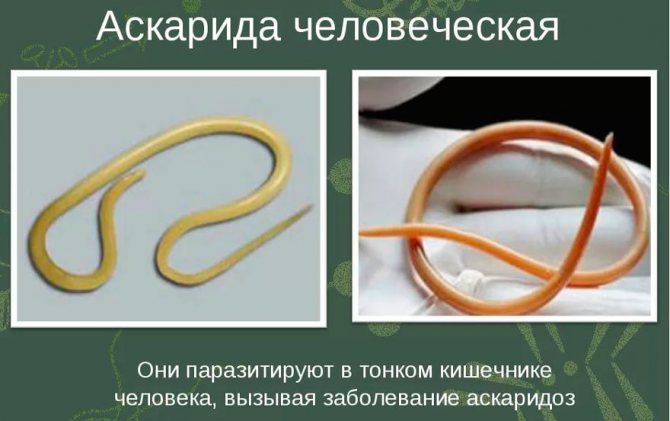

Symptoms and Diagnosis
Ascaris invasion is in many ways similar to other helminthiases, but it also has characteristic features. Experts list several signs indicating a possible human infection with these nematodes.
1. Stool disorders. The presence of worms in the intestinal tract almost always leads to mechanical irritation of the receptors located on the mucous membranes. Because of this, the patient is worried about the symptoms of indigestion - frequent urge to defecate and loose stools.
2. Abdominal pain. Discomfort in the intestine is not always observed, but only with extensive invasion, when the number of parasites increases to extreme values.
3. Allergic reactions. Rash, edema, urticaria - these symptoms in adults and children appear when the worms are in the larval stage, gradually transforming into sexually mature individuals. Experts call this period molting. It is he who is accompanied by the formation of characteristic spots on the skin.
4. Weakness. The symptom develops due to the nutritional characteristics of the worms in the host's body. Roundworms use already digested food, so a person loses a significant part of organic compounds.
What Ascaris eggs look like
What the eggs of ascaris look like and how you can recognize them in the feces, so that it is possible to determine the presence of worms in the body. The roundworm egg is quite small, and its size reaches about 0.05 mm. They are predominantly oval or round in shape. If the eggs of ascaris are unfertilized, then they have an irregular shape, since there is no embryo in them. The embryos are quite well protected due to the presence of a multilayer shell, which consists of five layers, namely:
- protein;
- three-layer shell;
- inner shell.
The outer protein layer is slightly brownish to mix with feces, and sometimes it may be completely absent. The three-layer inner shell is durable and glossy.It is these inner layers that protect the embryo from adverse conditions.
The inner shell is the thinnest and, thanks to a special porous surface, water and all the required nutritional components that contribute to the growth of the embryo easily pass through it. From infection to the first laying of eggs, it often takes several months. Only after a few months can the eggs of the worms be detected in the feces.
Vlasoglava
This type of parasite is quite rare in central Russia. Vlasoglava more often live in the southern regions, since the eggs of this worm love warmth. Most infections occur in rural areas.
Whipworm eggs live in the soil. Invasion occurs through hands, contaminated soil particles, poorly washed vegetables and fruits.
As a result of infection, a disease occurs - trichocephalosis. Vlasoglav is a parasite in the intestines. This worm causes anemia, as it feeds on human blood, and severe abdominal pain.


The eggs of the parasite are excreted in the feces, but they are very small, they cannot always be seen even under a microscope. Only with a very strong invasion is it possible to detect eggs in the analysis of feces. They are barrel-like in shape and have a brownish-yellow color. There are holes on 2 sides of the egg.
What do worms look like in feces? They are very difficult to find alive in feces, since whipworms cannot live long outside the human body. Only with anthelmintic therapy can be seen in the feces of dead white worms.
To diagnose trichocephalosis, the rectum and sigmoid colon are examined with a special device (sigmoidoscopy). Thus, accumulations of parasites in the intestine are detected. Treatment of the invasion is long-term, since the whipworm eggs are protected by a dense shell.
Ascaris life cycle
The life cycle of ascaris occurs in several different stages. After the eggs of the worms penetrate water or soil, they can remain viable for up to 7 months. Penetrating into the human body, they initially enter the small intestine, where the larvae hatch.
The larvae then enter the circulatory system and spread throughout the body. They can linger for a long time in the respiratory organs, since they need oxygen for normal life.
After about a week, the larvae of the worms begin to strongly irritate the respiratory system, while provoking a cough with sputum production. Thus, the larvae are re-swallowed, which penetrate the intestines. If two individuals of different sexes live in the small intestine, then after a certain time fertilization occurs and the life cycle of the worms repeats.
Many are interested in how many eggs one adult female roundworm lays daily and how many of them are fertilized. The number of eggs laid per day can reach more than 200 thousand pieces, however, only slightly more than half of them are fertilized.
Suckers
Of the worms of the fluke class, the most common in humans is the feline fluke (hepatic fluke). The habitat of worm eggs is fresh water. From there, the parasite enters the shellfish and then the fish. The fluke infects cats and humans through the consumption of poorly processed freshwater fish, as well as through contaminated water. A sick cat does not pose a danger to humans.


Burbot liver with parasites
Most often, fish of the cyprinid family are infected. Salting or smoking does not kill the parasite. A sufficiently long heat treatment of the product is required. You can become infected with a fluke by accidentally swallowing water from a pond or river. Cases of infestation after irrigation of beds with contaminated water are known.
Feline fluke damages the liver. There is pain in the abdominal cavity on the right side, nausea, vomiting, fever. During a medical examination, an increase in the organ is found.
Adult worms are not excreted in feces.What do the eggs of the fluke class worms look like under a microscope? When examining feces, you can see transparent ovals with a golden sheath. There is a plug on one side of the egg that opens when the larva hatches. For the purpose of diagnosis, an additional blood test for antibodies or an enzyme immunoassay is carried out.
Ascariasis symptoms
Waste products of adult ascaris and their larvae provoke the emergence of very serious disorders in the body. This can lead to intoxication, which is manifested by rashes on the skin, deterioration of immunity, and dysbiosis. A person whose body is parasitized by roundworms is much more difficult to tolerate the simplest diseases, and is also often prone to problems with the respiratory system.
Important! After the ascaris eggs have entered the body, absolutely no signs appear, and the first symptoms begin only when the larvae spread throughout the body.
The larger the worm, the more difficult it is to remove it from the body, since they go through a rather difficult stage in their development and his body becomes much more resistant to various kinds of external influences. Spreading throughout the body, the larvae of the worms take up many useful substances, which significantly increases their resistance to various external damage.
Resistance of Ascaris eggs to external factors
Eggs, which, together with feces, left the human body, must mature for some time in the ground. For the full development of the embryo, certain conditions must be provided. At a normal temperature, which is 25 degrees, the embryos ripen in literally 2 weeks.
It is after passing through the full maturation of ascaris embryos that they become infectious. In addition to ensuring the required temperature regime, for the full development of the embryos of worms, it is important that there is a certain level of humidity. If the eggs of worms penetrate into the sandy type soil, then the process of their development will occur rather slowly, since the sand heats up much faster, and the moisture will instantly evaporate.
The process of maturation of ascaris embryos in a temperate climate slows down quite strongly and can last up to 7 months. If the air temperature drops significantly, then the development of the embryo stops, but it remains viable for a long time, therefore, it continues its development immediately with the onset of heat.
Ascaris eggs tolerate a variety of, even negative climatic conditions quite well. They do not die even if severe frosts come. In temperate climates, worm eggs may well remain viable for several years. Alcohol and ether have a detrimental effect on them. In addition, they immediately die from exposure to direct sunlight and during boiling.
Persistence in the environment
The critical temperatures that the eggs of the human roundworm can withstand are -15 and +55 degrees Celsius. The wider temperature range kills them within minutes.
They are able to withstand wintering due to the fact that they are not on the surface, but in the thickness of the soil. This provides normal temperature, humidity and sun protection, which are just as harmful to the parasite.
As mentioned above, roundworm eggs are characterized by the presence of shells. They are needed to protect against alkaline environments and chlorine. Particular resistance is noted to acidic environments, since the parasite must pass through the gastric juice.
How does the infection take place
Infection with worms occurs by the oral-fecal route. This means that eggs are excreted from the body mixed with feces, then they fully mature in the ground and become infectious. They can penetrate into the human body if hygiene rules are not followed.Often, ascariasis occurs in children who can taste the earth or eat poorly washed fruits and vegetables.
Worms provoke many problems in a child, which is why, when the first signs appear, it is imperative to carry out immediate treatment.

